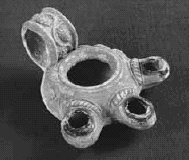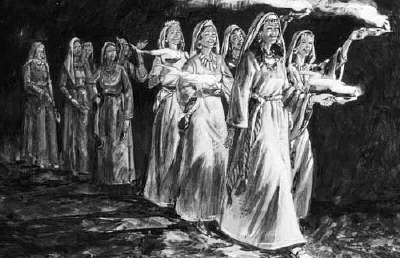Matthew 25: Are You Ready?
New Testament: Student Study guide, (2003), 33–34
Matthew 25 continues Jesus’ discussion of His Second Coming. In it He gave three parables. These parables can help us understand what we must do to be ready to meet Him and have that meeting be a pleasing and glorious experience.
Understanding the Scriptures
Matthew 25
| Tarried (v. 5) | Did not yet come | |
| Slumbered (v. 5) | Grew tired; fell asleep | |
| Trimmed their lamps (v. 7) | Cut the burned wicks and added oil to their lamps so they would work properly | |
| Delivered unto them his goods (v. 14) | Asked them to take care of his possessions | |
| Talents (vv. 15–28) | An amount of money (see Bible Dictionary, “weights and measures,” pp. 788–89) | |
| His several ability (v. 15) | What he could take care of | |
| Traded (v. 16) | Put the money to work in some kind of business activity | |
| Reckoneth with them (v. 19) | Asked them to report what they had done | |
| Reaping where thou hast not sown (v. 24) | Harvesting where you did not plant | |
| Slothful (v. 26) | Lazy | |
| Strawed (v. 26) | Scattered seeds | |
| Exchangers (v. 27) | Bankers | |
| Usury (v. 27) | Interest | |
| Unprofitable (v. 30) | Worth little or nothing |

Lamp
Matthew 25:1–13—Wedding Customs in the Parable of the Ten Virgins
In Jesus’ time it was the custom for the groom and his friends to go to the bride’s home to escort her to his home, accompanied also by her friends, or attendants. It was a great celebration that many people participated in. It usually happened at night, and torches and lamps were used as the people danced, sang, and rejoiced with the new couple.
Matthew 25:1–13—Additional Help from the Joseph Smith Translation
In addition to the Joseph Smith Translation changes for the parable of the ten virgins (found in the footnotes of the LDS edition of the Bible), Joseph Smith changed “I know you not” in verse 12 to “ye know me not” (JST, Matthew 25:11). This time of judgment is described in Mosiah 26:25–27.
Studying the Scriptures
Do activity C and then one of the three other activities (A, B, or D) as you study Matthew 25.
 Parable of the Ten Virgins
Parable of the Ten Virgins

Elder Harold B. Lee, then a member of the Quorum of the Twelve Apostles, said that the virgins symbolize “those who were professed believers in Christ” (in Conference Report, Oct. 1951, 26).
- 1.After reading the parable of the ten virgins in Matthew 25:1–13, read Doctrine and Covenants 45:56–57 and explain what the oil in the parable represents.
President Spencer W. Kimball said, “In our lives the oil of preparedness is accumulated drop by drop in righteous living. Attendance at sacrament meetings adds to our lamps, drop by drop over the years. Fasting, family prayer, home teaching, control of bodily appetites, preaching the gospel, studying the scriptures—each act of dedication and obedience is a drop added to our store” (Faith Precedes the Miracle [1972], 256). - 2.Knowing what you now know about the symbolic meaning of the oil and how we obtain it, explain why the five who had it could not share with those who did not.
 The Parable of the Talents
The Parable of the Talents
Although a talent was an amount of money in the time of Jesus, it can represent all that the Lord has given us.
- 1.As you read Matthew 25:14–30, list the rewards each of the three men received in the parable of the talents and explain why each man received that reward.
- 2.What one word would you use to explain why the third man did not do what the other two did with their talents? Use the Topical Guide and find a scripture that would encourage a person who might lose blessings today because they have a similar problem. Write that scripture in your notebook and explain why you think it would help.
 Scripture Mastery—Matthew 25:40
Scripture Mastery—Matthew 25:40
- 1.The parable of the sheep and the goats is recorded in Matthew 25:31–46. Perhaps its most important idea is stated in verse 40. Using what you learn from the rest of the verses, from the helps in your scriptures, and what you already know about the gospel, explain what the following specifically refer to in verse 40. Be as complete in your answer as possible.
- •“The King”
- •“Them” (who the king is speaking to)
- •“It” (meaning what “ye have done”)
- •“The least of these my brethren”
- 2.List the six things Jesus said the sheep did that allowed them to receive their reward at his right hand. For each of these six ways of helping another in physical need, give a suggestion for how each of them could represent a spiritual need and what you could do to help that spiritual need.
 Putting It Together
Putting It Together
Based on what you read in the three parables in Matthew 25, what would be three main ideas you would want to discuss if you were assigned to give a talk in Sacrament meeting on preparing for the Second Coming of Jesus Christ? Give a scripture reference in Matthew 25 for each idea.

No comments:
Post a Comment